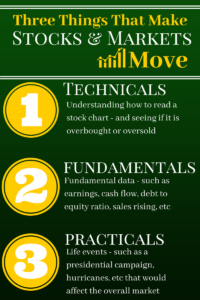There are 3 things that make stocks and the market move…
… and if you understand these factors, then you can learn how to spot them and capitalize on them when they happen.
1. Technicals
To understand the technical aspect of what makes stocks and the overall market move, you have to understand how to read a stock chart.
There are certain price levels where “technically” on a chart you can see that a stock or the overall market is overbought or oversold. What happens at these levels seems like a self-fulfilling prophecy because you have tons of traders all watching the same pattern.
When the stock or the market nears its “resistance” level, you see traders start to sell their positions and lock in their gains and play it safe.
As the stock or market begins to sell off, it will eventually hit a point where too many people overreacted and now it is a bargain again. This level is called “support”, and you see the buyers come back in and snatch up the stock or buy the overall market back up.
The key here is to know what the technical levels are so you can be on the right side of the trade and to recognize them before they happen.
THEN you can profit from the pattern!
Support and resistance lines are two things that move the market and the stock.
Which brings us to…
2. Fundamentals
So how do the fundamentals affect the stock?
Well first, let’s talk about what we look for in the fundamentals.
This area of influence on the stock and overall market strictly comes from fundamental data. This data could be earnings report, cash flow, debt to equity ratio, sales rising quarter over quarter and year over year etc.
 When a stock is fundamentally sound, people love to put their money there because it is safe and with a company who is fundamentally doing well and, based on the financials, should continue to do well into the foreseeable future.
When a stock is fundamentally sound, people love to put their money there because it is safe and with a company who is fundamentally doing well and, based on the financials, should continue to do well into the foreseeable future.
A fundamentalist trader looks at the cash flow and the value.
However, when there is a breakdown in fundamentals i.e sales decline, rising cost of materials for a product which means less profit, etc… traders and investors begin to leave the stock in search of better companies or places to put their money.
Once you learn the ins and outs of a business, and its past financial status, you can better understand the state of the stock and capitalize on it.
3. Practical
Ahhhh now on to the practical.
Many people underestimate the practical and this is the one that can be the most frustrating.
Practical is what I like to classify as life events, for example a presidential election year. This is a practical event that can move markets because of the thoughts and plans of the new leader and how it will affect the economy, healthcare business, etc.
Other practical events could include a hurricane or some type of storm that destroys business, farmers crops, and has an effect on food prices or supply and demand. It could also include an unexplained oil spill or explosion of a gas or oil rig or some random act of terrorism that causes people to stop going out and stop spending money – which in turn affects the sales and commerce of a town, country or company.
Although you cannot always prepare for the practicals, it is important to understand when they happen and think through the affect it can have on stocks, the overall market and more importantly for how long.
The point is…
…if you understand these 3 vital causes that make the market move – you know when to detect change and ride that money train. But you have to catch it early or else you could miss it.
In our weekly Group Coaching sessions, the members of Power Trades University and I discuss what factors are making the current market move – and the best way to potentially capitalize on it.
To learn more about getting started in the stock market, check out our free 10-page Starter Pack PDF to get the 3 first vital steps.
